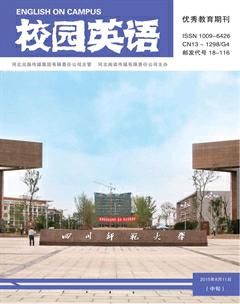An Analysis of Chinese College Students’ Reasons for and Attitudes towards Chinese—English Code—Switching (CS)in Their Daily Speech
【Abstract】Since English became a compulsory subject for Chinese college students in 1986,English learning and speaking has been popular in Chinese universities.Under this background,Chinese college students tend to code-switch between Chinese and English,which means to mix English when they speak Chinese.In the past decades,many researchers have studied code-switching (CS)from different perspectives.This paper studies what researchers have said about CS in the previous studies.
【Key words】Chinese-English; code-switching; motivations attitudes
With the growing cooperation and communication with different countries,more and more Chinese people are influenced by different languages,especially English.As the most widely-spoken language,English learning and speaking has been an inevitable trend.In 1986,China carried out the National College English Curriculum (NCEC),making English a compulsory subject for Chinese college students.As a result,Chinese college students “use English and their native language,Chinese,in the same conversation and interaction” (Chen,2009,p.13).This phenomenon of combining Chinese and English in speech is called Chinese-English code-switching (CS).According to Richard et al (2000),code is “a term which is used instead of language,speech variety or dialect” (p.70).Thus,code-switching (CS)means the change from one language or language variety to another one.
Since the 1970s,as a common social phenomenon,code-switching (CS)has been a popular research topic in sociolinguistics.In the past decades,many linguistic scholars have studied the different types of CS,the motivations and functions of CS.
To start with,the categorization of CS has been studied by many scholars.According to linguist Poplacks (1980)theory,CS can be divided into three types: inter-sentential CS,intra-sentential CS and tag CS.Similarly,another scholar Gumperz (1972)also divides CS into three types: situational CS,metaphorical CS,and conversational CS.Based on these two scholars studies,Chinese linguist Bi (2011)finds that Chinese-English CS is also divided into three types: word mixing,affix mixing,and phrases or sentence mixing.
As for the functions of CS,it is closely related to the motivations.According to the scholar Crystal (1987),there are mainly three motivations for CS: to explain what the speak has said to make himself/herself understood; to build a relationship with people speaking the same language; to show the speakers attitude with changing the code.Besides,as Chen (2009)asserts,there are totally 13 motivations for Chinese-English CS,which can be discussed from three aspects: the linguistic reality,the social conventions,and the psychological motivations.
In addition,some scholars put forward their own views about Chinese-English CS phenomenon and its future development.For example,Chinese scholar He (1992),who holds a positive attitude towards CS,states that “Since the communication between different nations is necessary,CS is unavoidable” (p.10).Also,Bi (2011)presents that CS adapts to the international situation and peoples cognitive psychology,and enriches a language,thus he thinks CS is an inevitable trend.However,Chinese scholar Ren (1994)argues that “it is unnecessary to borrow or abuse the foreign words to express the things and concepts that have existed in our own language” (p.18).
In conclusion,different people have different opinions about CS.However,generally,more people think CS is a good phenomenon.It proves that Chinese-English CS is an inevitable trend in China.
References:
[1]Bi,Q.B.(2011).Research on the Chinese-English code mixing phenomenon (Master dissertation).Available from CNKI database.
[2]Chen,H.Y.(2009).Motivation research on Chinese-English code-switching on campus (Master dissertation).Available from CNKI database.
[3]Crystal,D.(1987).The Cambridge encyclopedia of language[M].Cambridge,England: Cambridge University Press.
[4]Gumperz,John.(1972).Directions in sociolinguistics.Oxford,England: Basil Blackwell.
[5]Poplack,S.(1980).Sometimes Ill start a sentence in Spanish y ternimo en espasnol: Toward a typology of code-switching.Linguistic,18(1),581-618.
[6]Wardhaugh,R.(2000).An introduction to sociolinguistics[M].Beijing: Foreign Language Teaching and Research Press.
作者简介:
唐慧莹,1994年2月生,女,汉族,重庆长寿人,大学本科在读,研究英语文学。

